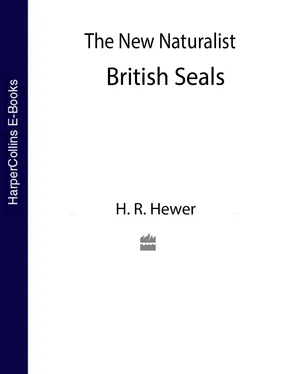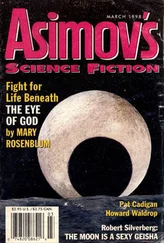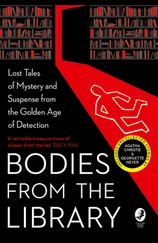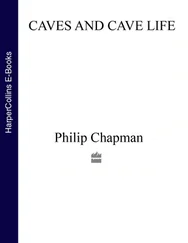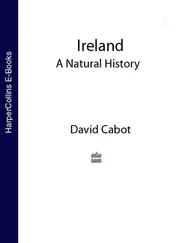11. External differences between grey and common seals and between bull and cow grey seals
12. Jaws and teeth in grey and common seals
13. Growth and maturation of the os penis
14. The os penis index
15. Distribution by age of cow and bull grey seals
16. The male genitalia of the grey seal
17. Growth and maturation of the testis in the grey seal
18. Variations during the year in adult testicular weights in the grey seal
19. The female genitalia of the grey seal (adult)
20. The female genitalia of the grey seal at birth
21. Foetal growth rate in the grey seal
22. Counts of grey seals on West Hoyle Bank and on the Farne Islands
23. Counts of grey seals on West Hoyle Bank, 1951–56 and 1966–70
24. Early stages in territory formation on Shillay
25. Daily pupping rates for Ramsey Island, North Rona, Staple Island and Brownsman
26. Daily pupping rates in neighbouring rookeries
27. Breeding sites on Ramsey Island
28. Breeding sites on Eilean nan Ron and Ghaoidmeal
29. Breeding sites on Shillay
30. Breeding sites on North Rona
31. The Outer Farne Islands
32. Breeding sites on the Farne Islands
33. Different types of social arrangements in different groups of grey seals
34. The grey seal pup in the first four weeks
35. Bull territories on Shillay
36. Types of marker used on grey seal pups
37. Recoveries of young marked grey seals
38. Growth rates in grey seal pups
39. World distribution of common seals
40. Distribution of common seals in British waters – recorded sightings
41. Distribution of common seals in British waters – breeding areas
42. Rare species of pinnipede in British waters – ringed seal, harp seal and bearded seal
43. World distribution of ringed seals
44. World distribution of harp seals
45. World distribution of bearded seals
46. Rare species of pinnipede in British waters – hooded seal and walrus
47. World distribution of hooded seals
48. World distribution of the walrus
49. Numbers of pups born on the Farne Islands, 1956–70
50. Maximum counts and numbers of pups born on the Farne Islands, 1956–68
51. The Farne Islands
52. Average monthly counts on the Farne Islands, 1956–68
53. World distribution of Phocidae
54. World distribution of Otariidae and Odobænidae
SEALS are fascinating animals. Everyone knows what they look like, but most people, even some experienced naturalists, have only seen them alive in zoos, where the seals, and their relatives the sea lions, are such firm favourites with the crowds. It is not really difficult to see quite large numbers of both grey and common seals by visiting the correct coastal areas of Britain, but few casual visitors find themselves in the right place at the right time. The exception is the Farne Islands, where for many years great numbers of tourists have been able to see equally large numbers of grey seals, and to see the animals from boats without having to make the effort of walking long distances over sandy beaches and mud flats, or of scrambling energetically down steep and often treacherous cliffs.
Although seals are so well known, and are the subject of many fables and nursery tales, our knowledge of their life history and ecology was, until recently, very imperfect. We had little accurate knowledge of the size of their populations, and of whether they were increasing – as fishermen who believed they endangered their livelihood said – or whether they were in imminent danger of extinction – as some conservationists firmly insisted. Legislation on their protection, and efforts towards their control, were based on guesswork.
Professor Hewer would be the first to insist, as he does in several places in this book, that our knowledge is still imperfect and that much more research on these animals is still needed. But nevertheless our knowledge is now reasonably firmly based, and we are therefore glad to be able to publish this up to date and authoritative book at this time. We believe that, for the first time, it gives in one place the overall picture of these animals that many have been waiting for. It also enables the reader to understand the complex problems of seal conservation. Seals must be preserved, and this may sometimes include killing seals where (as in the Farne Islands) their numbers are too great for the habitat to support.
Professor Hewer modestly plays down his own contribution to our vastly increased knowledge of seals. He has himself, for over twenty years, been closely involved in all the major research in Britain. He has combined the careful laboratory investigations of the trained scientist with detailed studies of the animals, alive, in their natural habitats. As one fully employed as a university teacher (where his many students will testify to his conscientiousness) he has not always had the time or the opportunity to do, himself, all the experimental or observational work he would clearly have enjoyed, but all other workers in this field have gained so much from his freely given help and advice that his contribution to the whole subject has been unique. All other workers on British seals will readily acknowledge Professor Hewer as their spokesman.
Scientific knowledge of a subject is one thing, and this is the basis of this book, but its value is immensely enhanced by the fact that Professor Hewer really ‘knows’ seals. He has watched and lived alongside his subjects, and has come to know them as only one who is a skilled observer and a field naturalist can. These genuine observations on the living animals give this book a quality rarely found in works which also satisfy the most rigid canons of scientific accuracy.
THIS book has taken an unconscionable time being born. The usual excuses can be given but basically the subject has been a particularly active field of research over the past ten years, not only for myself but for the number of workers who have been drawn into it and whose contributions have been constantly filling in gaps in our knowledge. It has always been tempting to put off the day so that something interesting and useful might be included. The present moment is apt, not because there is a lull in research work, but because several events have combined to give research an added impetus and considerable advances can be anticipated in the near future. A stock-taking is therefore appropriate and this I have attempted to do.
Public opinion during this time has been aroused and the whole question of our seal populations has become over-heated largely in inverse ratio to the information available. While such debate is not conducive in itself to the elucidation of facts, it does create a political atmosphere in which funds become available for research. While my own work in the laboratory has been covered by the usual university finance, the collection of material and the field observations could only have been possible with the aid of official support, in this case through the Nature Conservancy. As the problems grew in number and scope, the appointment of special workers in seal biology became possible and I have not suffered the undue frustration of seeing interesting aspects neglected because they were beyond the capabilities of myself.
When I became involved in this work (1951) Mr J. L. Davies had already given some account of grey seal breeding on Ramsey Island and this had been followed up by Dr L. Harrison Matthews and others in 1950. Apart from Fraser Darling (now Sir Frank Darling) these were the only zoologists to interest themselves actively in research on British seals this century. Yet there were a number who had experience in Antarctica such as Dr Matthews himself and much is owed to their interest and encouragement over the last twenty years. It is very fitting that the head of the newly formed Seals Research Unit at Lowestoft, Nigel Bonner, served his apprenticeship in the antarctic.
Читать дальше
